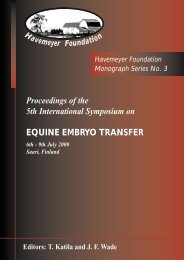Proceedings of a Workshop on - The Havemeyer Foundation
Proceedings of a Workshop on - The Havemeyer Foundation
Proceedings of a Workshop on - The Havemeyer Foundation
You also want an ePaper? Increase the reach of your titles
YUMPU automatically turns print PDFs into web optimized ePapers that Google loves.
<strong>Havemeyer</strong> Foundati<strong>on</strong> M<strong>on</strong>ograph Series No. 11<br />
single 4-0 polydioxan<strong>on</strong>e suture is used to hold the<br />
pedicle graft into the CAD muscle. A stent<br />
bandage is usually sutured over the skin incisi<strong>on</strong><br />
and an elastic bandage is used to apply pressure<br />
over the incisi<strong>on</strong> area, minimising the opportunity<br />
for seroma formati<strong>on</strong>.<br />
Since September 2000 left cordectomy using a<br />
diode laser in combinati<strong>on</strong> with the nerve muscle<br />
pedicle graft has been used. <strong>The</strong> cordectomy is<br />
routinely performed the day following the nerve<br />
muscle pedicle graft procedure in the standing<br />
sedated horse.<br />
Horses are routinely kept c<strong>on</strong>fined to a stall<br />
for 2 weeks following surgery. After stall<br />
c<strong>on</strong>finement, a further 2 weeks in a day yard<br />
followed by paddock turnout for 12 weeks is<br />
normally recommended. At this stage it is advised<br />
that the horse should go into training – 16 weeks<br />
post operatively. When the horses are returned to<br />
exercise it is advised that episodes <str<strong>on</strong>g>of</str<strong>on</strong>g> fast exercise<br />
are introduced as early and as frequently as<br />
possible. As the omohyoideus muscle is an<br />
accessory muscle <str<strong>on</strong>g>of</str<strong>on</strong>g> respirati<strong>on</strong>, c<strong>on</strong>siderable<br />
respiratory effort must be undertaken to activate<br />
the first cervical nerve.<br />
After 6 weeks <str<strong>on</strong>g>of</str<strong>on</strong>g> training, trainers/owners are<br />
requested to present the horse for endoscopic<br />
assessment <str<strong>on</strong>g>of</str<strong>on</strong>g> the larynx. At rest, the left arytenoid<br />
cartilage most comm<strong>on</strong>ly looks exactly as it did<br />
prior to surgery. Two diagnostic reflexes have been<br />
developed to stimulate c<strong>on</strong>tracti<strong>on</strong> <str<strong>on</strong>g>of</str<strong>on</strong>g> the<br />
omohyoideus muscle and therefore the newly<br />
innervated CAD. <strong>The</strong> first involves stretching the<br />
head and neck upward as high as possible while<br />
observing the larynx closely through the<br />
endoscope. If re-innervati<strong>on</strong> has occurred, there is<br />
<str<strong>on</strong>g>of</str<strong>on</strong>g>ten a sp<strong>on</strong>taneous flicker or single abducti<strong>on</strong> <str<strong>on</strong>g>of</str<strong>on</strong>g><br />
the left arytenoid cartilage. <strong>The</strong> sec<strong>on</strong>d reflex<br />
involves pulling back rapidly with a finger or<br />
thumb <strong>on</strong> the commissure <str<strong>on</strong>g>of</str<strong>on</strong>g> the lips. Again a<br />
sudden abducti<strong>on</strong> <str<strong>on</strong>g>of</str<strong>on</strong>g> the left arytenoid cartilage<br />
occurs if re-innervati<strong>on</strong> has been successful. This<br />
reflex can be stimulated from the left or right side<br />
<str<strong>on</strong>g>of</str<strong>on</strong>g> the head.<br />
COMPLICATIONS<br />
Complicati<strong>on</strong>s associated with laryngeal reinnervati<strong>on</strong><br />
have been few when compared to<br />
prosthetic laryngoplasty. <strong>The</strong> most frequent<br />
complicati<strong>on</strong> has been seroma formati<strong>on</strong> 3–5 days<br />
following surgery. <strong>The</strong> use <str<strong>on</strong>g>of</str<strong>on</strong>g> a compressive neck<br />
bandage that encircles the neck rostral and caudal<br />
to the poll and maintained for 4–6 days post<br />
operatively has reduced this to some extent. Some<br />
seromas have become infected, and these have<br />
been treated with antibiotics selected from culture<br />
and sensitivity results. One horse developed a<br />
large hematoma immediately post operatively that<br />
required the incisi<strong>on</strong> to be re-opened and the<br />
vessel ligated.<br />
RESULTS<br />
Thoroughbreds<br />
Raced Thoroughbreds – 63 horses were included<br />
in this group, 24 were Grade 4 horses, while 39<br />
horses had Grade 3 laryngeal hemiplegia. Of the<br />
59 horses available for follow up, 95% went <strong>on</strong> to<br />
start in <strong>on</strong>e or more races. <strong>The</strong> average length <str<strong>on</strong>g>of</str<strong>on</strong>g><br />
time from surgery to race <strong>on</strong>e was 7.5 m<strong>on</strong>ths for<br />
Grade 3 horses and 8.6 m<strong>on</strong>ths for Grade 4 horses.<br />
<strong>The</strong> earliest that re-innervati<strong>on</strong> was identified was<br />
at 4 m<strong>on</strong>ths, and the latest at 9 m<strong>on</strong>ths. Following<br />
surgery, the horses raced an average <str<strong>on</strong>g>of</str<strong>on</strong>g> 12.5 times<br />
each. Of the 59 horses, 32 (54%) w<strong>on</strong> <strong>on</strong>e or more<br />
races after surgery.<br />
To analyse the effectiveness <str<strong>on</strong>g>of</str<strong>on</strong>g> the nerve<br />
muscle pedicle graft, the following 4 variables,<br />
before and after surgery, were calculated for each<br />
horse: total performance ranking, total prize<br />
m<strong>on</strong>ey, performance ranking per start, and prize<br />
m<strong>on</strong>ey per start.<br />
1. Total performance ranking<br />
Thirty-four <str<strong>on</strong>g>of</str<strong>on</strong>g> the 59 (58%) horses had an<br />
improved total performance rank after surgery.<br />
2. Total prize m<strong>on</strong>ey<br />
Thirty-<strong>on</strong>e <str<strong>on</strong>g>of</str<strong>on</strong>g> 59 horses (53%) earned more<br />
prize m<strong>on</strong>ey after surgery.<br />
3. Performance ranking per start<br />
Thirty-four <str<strong>on</strong>g>of</str<strong>on</strong>g> the 59 horses (58%) had<br />
improved performance ranking per start after<br />
surgery.<br />
4. Prize m<strong>on</strong>ey per start<br />
Thirty-four <str<strong>on</strong>g>of</str<strong>on</strong>g> the 59 horses (58%) earned<br />
more m<strong>on</strong>ey per start after surgery than<br />
before.<br />
Unraced Thoroughbreds – 66 horses were<br />
included in this group, 19 were Grade 3 left<br />
laryngeal hemiplegia (LLH) while 47 had Grade 4<br />
laryngeal functi<strong>on</strong>. Of the 66 horses, 39 (60%)<br />
went <strong>on</strong> to start in at least <strong>on</strong>e race, 15 horses were<br />
c<strong>on</strong>sidered to be failures, 2 died, 3 were retired for<br />
61








